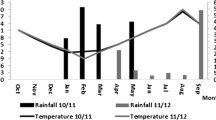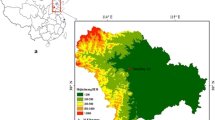Abstract
Field assessments at regular intervals from April 1975 to March 1979 recorded 61 plant species comprising 13 grasses, 20 weeds and 28 trees and shrubs as emitting appreciable amounts of pollen into the atmosphere of Visakhapatnam. The data also showed relative prevalence of these taxa in different zones of the city and their flowering periods. Pollen output in terms of number per anther and per flower was determined for 29 taxa. Air sampling with rod traps of 0·53 cm diameter enabled the identification of 23 different pollen types in the atmosphere with Poaceae accounting for Ca. 37% of the total pollen load.Casuarina contributed to 13% followed by Cyperaceae 6%,Eucalyptus 5·8%,Dodonaea 3·8%, Amaranth-Chenopod andPhoenix each 3·4%,Borassus 2·4% andPeltophorum 2%. Of the total identified pollen, ca 85% belonged to anemophilous taxa. There was no pollen-free day. The total pollen and individual types displayed seasonality quite closely corresponding with the blooming seasons of the source plants. Three pollen peaks, two in the wet period (June–November) and one in the dry period (December–May) were evident. Year to year variations in pollen abundance occurred and urban growth affected pollen frequency pointing to the need for routine monitoring of the atmosphere.
Similar content being viewed by others
References
Davis D J 1972 NIAID initiatives in allergy research;J. Allergy Clin. Immunol. 49 323
Dua K L and Shivpuri D N 1962 Atmospheric pollen studies in Delhi area in 1958–59;J. Allergy 33 507–512
Duchaine J 1959 Allergy of the upper respiratory tract. InInternational Text-book of Allergy (ed) J M Jamar Copenhagen pp. 154–195
Gregory P H 1973The Microbiology of the Atmosphere 2nd (ed) Leonard Hill pp. 377
Hirst J M 1973 A Trapper’s line;Trans. Br. Mycol. Soc. 61 205–213
Hyde H A 1972 Atmospheric pollen and spores in relation to allergy I;Clin. Allergy 2 153–179
Hyde H A and Adams K F 1960 Airborne allergens at Cardiff, 1942–59;Acta Allergol. 15 159–169
Hyde H A and Williams D A 1945 Studies in atmospheric pollen II. Diurnal variation in the incidence of grass pollen;New Phytol. 44 83–94
Hyde H A and Williams D A 1961 Atmospheric pollen and spores as causes of allergic disease: hay fever, asthma and the aerospora;Adv. Sci. (London)17 525–533
Mittre V and Khandelmal A 1973 Airborne pollen grains and fungal spores at Lucknow during 1969–70;Palaeobotanist 22 177–185
Newmark M F 1970 Recent developments in pollen Aerobiology;Ann. Allergy 28 149–152
Nilsson S and Nybom R 1978 Particles on pollen; pp. 14–15, InInternational Aerobiology News Letter (Special Issue) No. 8
Ogden E C, Raynor G S, Hayes J V, Lewis M D and Haines J H 1974Manual for sampling airborne pollen; (New York: Hafner Press) pp, 182
Ramalingam A 1962 The construction and use of a simple air sampler for routine aerobiological surveys;Environ. Health 10 61–67
Solomon W 1976 Volumetric studies of aeroallergen prevalence I; Pollens of weedy forbs at a midwestern station;J. Allergy Clin. Immunol. 57 318–327
Solomon M A and Buell F M 1969 Effects of suburbanization upon airborne pollen;Bull. Torrey Bot. Club 96 435–444
Subba Reddi C 1970 A comparative survey of atmospheric pollen and fungus spores at two places twenty miles apart;Acta Allergol. 25 189–215
Subba Reddi C 1974 A study of potentially allergenic pollen producing plants of Visakhapatnam;J. Palynol. 10 155–157
Subba Reddi C 1976 Floral mechanism, pollen productivity and pollen incidence inMadhuca indica Gmelin. with remarks on the mode of pollination;New Botanist 3 11–16
Venkateswarlu J, Bhiravamurty P V and Narasimha Rao P 1972The Flora of Visakhapatnam; Andhra Pradesh Akademi of Sciences, Hyderabad, pp. 260
Author information
Authors and Affiliations
Rights and permissions
About this article
Cite this article
Bai, A.J., Reddi, C.S. Airborne pollen grains of Visakhapatnam: A combined field and air sampling study. Proc. Indian Acad. Sci. 91, 329–350 (1982). https://doi.org/10.1007/BF03053359
Received:
Revised:
Issue Date:
DOI: https://doi.org/10.1007/BF03053359




